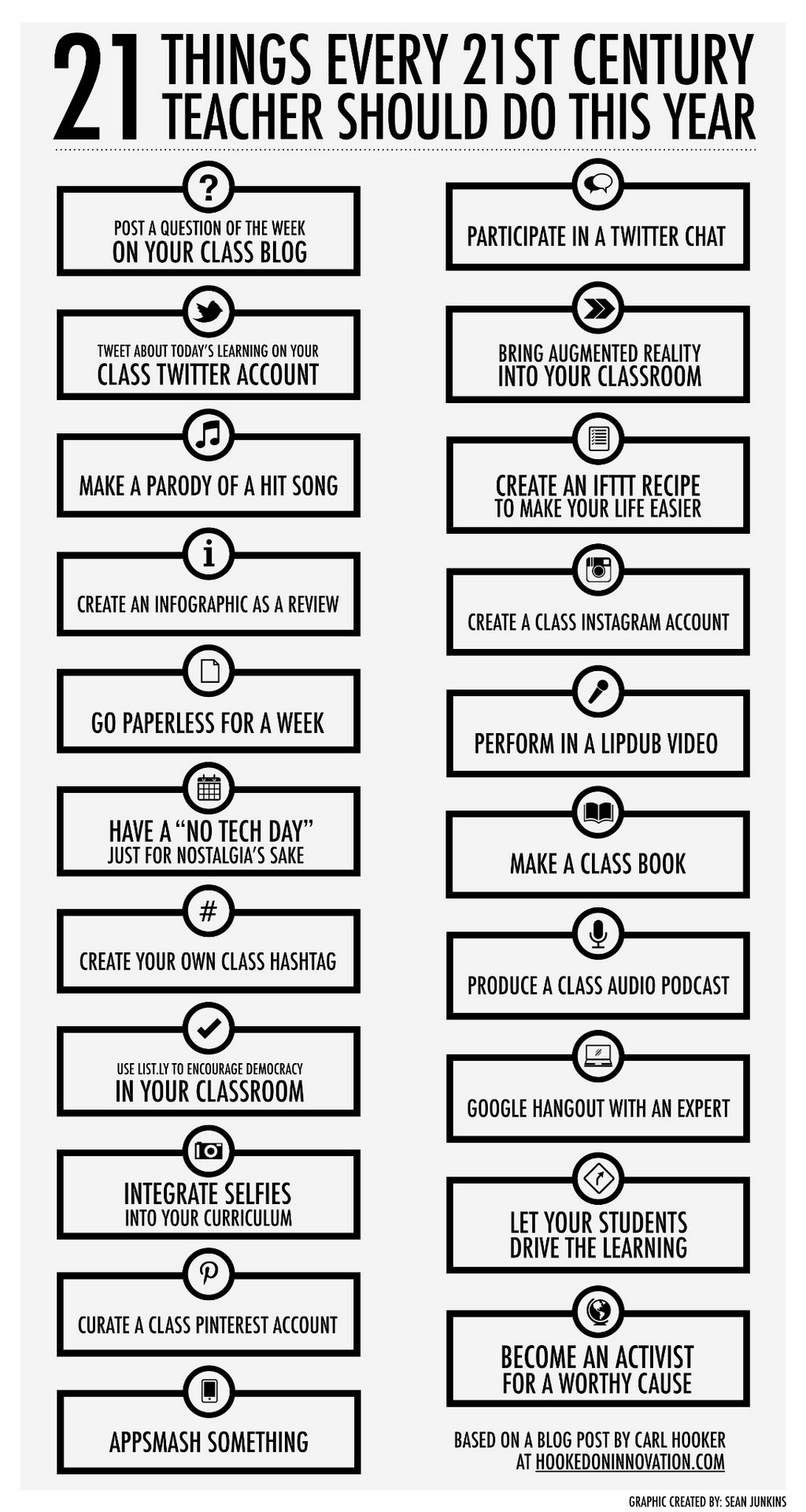This post first appeared on Carl Hooker's blog: Hooked on Innovation

A new school year always brings about new ideas and hopeful ambition for teachers. However, it’s almost 2015. Gone are the days when we can use the excuse that “we don’t do technology”. Part of being a teacher in the 21st century is being creative in integrating academics and learning into student’s digital lives. With access to content being ubiquitous and instant in student’s out of school lives, we can either reject their world for our more traditional one, or embrace it.
While some of the ideas that follow may seem a bit trendy, it’s never hurts to model ways to interact with all this new media as a covert way of teaching digital literacy and citizenship. The great news is, you don’t need every student to have a device to make these happen. Heck, in most cases all you would need is a single smart phone. All you need is an open mind and some student-led creative thinking.
And so, I present the 21 things every 21st century teacher should try in their classroom this year:
1. Post a question of the week on your class blog
One of the best ways to engage student (and family) interaction with your classroom is to have a class blog. While these are becoming more common, I like the trend of having a weekly student “guest author” write up the ideas and learning objectives discussed in class. This is also a good place to discuss appropriate commenting behavior on blogs and websites.
2. Have a class twitter account to post a tweet about the day’s learning
Just like a blog only smaller. Nominate a “guest tweeter” and have them summarize the day’s learning in 140 characters or less. Then ask parents to follow the account so they can also get a little insight into the happenings of the school day.
3. Make a parody of a hit song
The ultimate form of flattery is imitation. The ultimate form of stardom is when Weird Al makes a parody of your song. Why not take that to an creative level and have students re-write lyrics to their favorite hit or a popular tune? Sure, this might take more time than it’s worth academically, but the collaborative sharing and engaging aspect of producing such a thing can be a positive. Who knows, maybe someone in history class will remake “Chaka Khan” into “Genghis Khan” or something like this classic:
4. Create an infographic as a review
Those clever little graphics are appearing everywhere from Popular Mechanics to Cosmopolitan. Why not make one as a way to help visual learners review and remember information?
5. Go paperless for a week
Depending on your grade level, this might be harder than you think. Even in a 1:1 district we still print or have need to print things from time to time. The idea behind this challenge is see if you can figure out ways to make things more digital. Maybe instead of a newsletter you print and send home, you write a blog or send a MailChimp? Or instead of asking kids to write and peer-edit each other’s papers, you ask them to share a Google doc? If your students don’t have devices, then challenge yourself to try this personally for a month.
6. Have a “No Tech Day” just for nostalgia’s sake
And then have your students blog about the experience.
7. Create your own class hashtag
Tell your students and their parents about the hashtag and have them post ideas, photos, and questions to it. It’s a great way to get people from not only in your class but also around the world to contribute to your class conversation. You can also use this with your blog posts (#1) or classroom tweets (#2). Bonus points if you use something like VisibleTweets to display your posts in your class.
8. Create a List.ly list to encourage democracy in your class.
It could be as simple as a list of choices for a project or something as grand as what is one thing you want to learn about this year? Whatever the choice, use List.ly to create a crowd-sourced voting list and let your students have some say in their learning!
9. Integrate Selfies into your curriculum
This one might take some outside the box thinking, but I’m guessing that there are students in your class that could come up with a creative way to do this. Maybe take a selfie next to a science experiment? Or a selfie with an A+ paper? #SuperStudent
10. Curate a class Pinterest account
Pinterest is a great visible way to curate resources but why not create a class account that has a different board based on projects throughout the year. Add students as collaborators and let them post their projects to the board. You could also have a board on gathering resources and information for a topic which would be a good time to mention what is and what isn’t a valid resource?
11. AppSmash Something
Besides just fun to say, you should definitely take multiple apps on whatever device you use and smash them together into a project. Check out this post for the basics and remember, it doesn’t have to be you who is doing the smashing. Let your kids come smash too!
12. Participate in a Twitter Chat
Twitter can be like drinking information from a fire house at times, but finding a good twitter chat on a topic and participating can be a great way to learn and grow as a teacher. Check out Cybraryman’slist of twitter chats and times to find one that interests you. Don’t see any you like? Make your own!Remember in step #7 when you created your own class hashtag?
12. Make part of your classroom “Augmented”
Why not make take an app like Aurasma and hide some easter eggs around your room? You could make them about a project or just secret nuggets about you. It’ll keep kids (and parents during back to school night) engaged and turn dead space in your classroom into an interactive learning opportunity. Need some ideas? Check out Lisa Johnson‘s List.ly List (Remember, you know how to make those now from #8!) of over 50 Augmented Reality apps.
13. Create a recipe on IFTTT.com to make your life easier
With all of these tools and social media platforms, it might be a good idea to create some ways to automate tasks in your classroom. IFTTT.com has some great pre-made “recipes” to combine some of your accounts into simple workflow solutions. You can even have your plant email you when it needs water.
14. Create a Class Instagram Account
Have a daily student photographer who’s job is to post an example of something your class/students did that day. If you don’t want to mess with “do not publish” lists, you could ask that it be of an object or artifact, not a person. This would also be a good time to talk about when and how to ask permission to take someone’s photo. Mix in your class hashtag(#6), throw in an IFTTT (#13)recipe, and all the sudden you can also auto-post selfies (#9) to your class Pinterest board (#9)
15. Perform in a LipDub Video
This can be either a solo project or for even greater effect, tie in your parody song (#3) and have your students act out their learning throughout the video. Don’t forget to hashtag it. Bonus points if said video goes viral like this one:
16. Make a class book
The ease with which you can publish books now is amazing. Using a tool like Book Creator or iBooks Author, you can publish to the iBooks store or Amazon. Don’t want to do something that intense? Keep it simple and make a book using Shutterfly and then have it printed as a keepsake.
17. Participate in a Mystery Hangout
This sounds a lot scarier than it is but essentially think of playing the game 20 questions with another classroom somewhere in the world. Here’s a link to a community page with more resources. It’s a great way to increase cultural and global awareness and you could event invite the other class to add to your Pinterest board (#10), vote on your List.ly (#8), comment on your blog (#1) or maybe co-collaborate on an eBook (#16).
18. Produce a class Audio podcast
Have students create a podcast highlighting classroom activities, projects or students. To get it to the web quickly, post it to Soundcloud. For the more advanced user, use a podcasting site likePodbean.com and actually get the podcast posted to iTunes. That way mom and dad can listen to the weekly recap while going on their evening walk or driving to work.
19. GHO on Air with an expert
With so many resources and experts available, it only makes sense to bring in someone from “the real world”. This not only creates interest in the topic, it adds an air of authenticity. Using Google Hangouts On Air means you can record this session on the fly and post it to your class site or embed it on your blog to generate discussion at home.
20. Become an activist for a worthy cause.
If the ALS Ice Bucket Challenge can teach us anything, it’s that sometimes a little creativity is all you need to awareness to a cause. Whether it’s helping a country in need or finding a cure for a disease, our new connected society can be a powerful thing when galvanized for good. Participating in a global project gives students perspective on their own lives while helping others with their own life challenges.
21. Let your students drive the learning
While you could do all of these challenges by yourself, the real power comes in letting students own a piece of it. They have the curiosity and the digital acumen, it’s the teacher’s job to give them instructional focus and empowerment. We live in wonderfully connected times. Despite all of technology’s perceived misgivings and the apocalyptic fears that we are losing ourselves as a society, why not use some of this power for good?
Just know that as a teacher in the 21st century you ultimately hold the key to unleash this creative beast. So try something on the list this year that may force you a bit out of your comfort zone because there is no better way to learn than trying.
Just be sure you blog about it when you are finished as learning in isolation helps no one.
Oh….and be sure to hashtag it.
Update: Thanks to Sean Junkins who made this great little graphic for the challenge. Collaboration at it’s finest!


